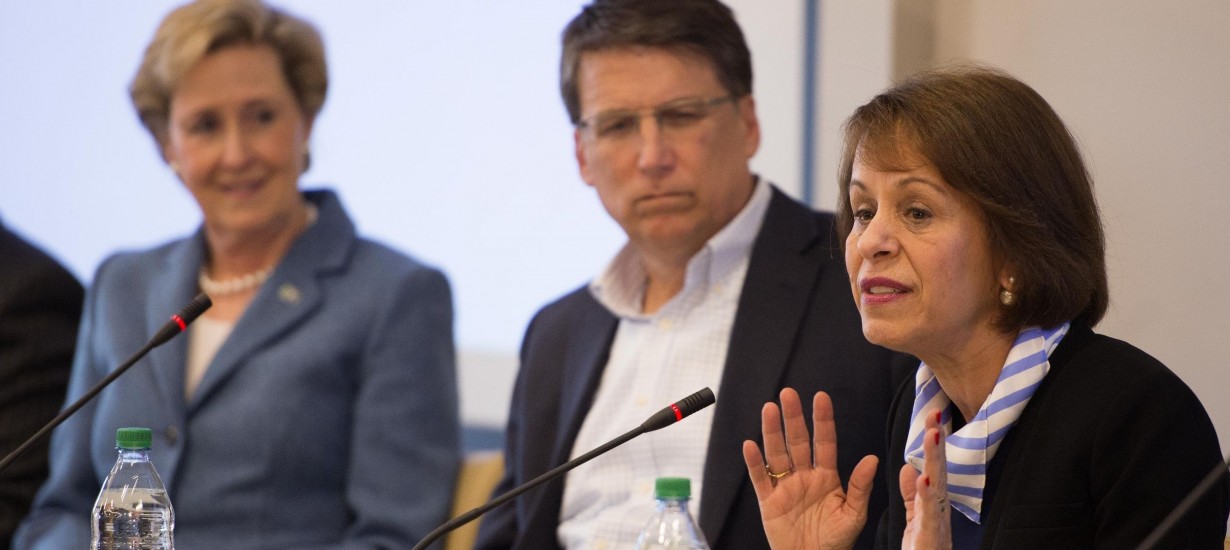McCrory, Folt Discuss Problems, Promise of Medical Education and Proposed Bonds

Gov. Pat McCrory spent 30 minutes walking the hallways of the UNC School of Medicine’s Berryhill Hall on Wednesday, visiting the outdated labs and dilapidated lecture spaces that can no longer hold classes.
But it took him all of five minutes, he said, to realize the facility no longer meets the needs of its students — the state’s future doctors.
“It’s not 21st-century teaching or education for 21st-century doctors,” McCrory said.
Bringing UNC’s medical school up to modern times was among the many goals discussed Feb. 17 at a Connect N.C. Bond proposal panel discussion hosted on campus.
McCrory and Chancellor Carol L. Folt were joined Wednesday by N.C. Department of Natural and Cultural Resources Secretary Susan Kluttz; N.C. National Guard Adjutant General Maj. Gen. Gregory A. Lusk; and Alamance Community College President Algie C. Gatewood at the panel to support the $2 billion bond referendum, which will be voted on March 15.
In addition to providing millions of dollars for water and sewer systems, National Guard Centers and updates to 45 state parks, the bond would provide nearly $1 billion for the UNC System to build and repair facilities and more than $300 million to modernize facilities in the 58-member community college system as well.
“It’s a partnership between the governor and the Legislature, between every single one of our universities, colleges and community colleges, and it’s a partnership with the citizens of the state of North Carolina because it’s a partnership to really build and improve the infrastructure as an investment for the future,” Folt said of the bond, which will require no new taxes to finance.
The last time voters approved a bond like this was 15 years ago. Since then, North Carolina’s population has grown by 2 million people.
A main goal of the Connect N.C. Bond proposal, McCrory said, is to support areas where there are skill gaps in the professions the state needs to fill the most. It is an effort to provide a stronger economy. With more than 30 percent of doctors in North Carolina retiring in the near future, the ability to recruit and train new physicians is crucial.
But the medical school’s educational facility, Berryhill Hall, was designed in the 1960s with spaces designed for lectures — not modern interactive teaching practices.
“This is at a point in time where we’re trying to recruit the best doctors in the United States of America to come to our schools here in North Carolina, and the facility was an embarrassment,” McCrory said. “It was an embarrassment that we’re training the best of the best in some of the worst facilities that I’ve seen: paint peeling off the ceiling, stairwells in terrible shape, the ventilation of the chemical labs in terrible shape. The floor plans were extremely inefficient. The quality of the workspace for the students was worse than bad. We need to rectify that.”
At Carolina, the bond will provide $68 million for the construction of a new medical education building that will meet current trends in education and the needs of medical students.
“This is really critical,” Folt said. “This medical school is top ranked in so many ways, it produces amazing doctors, and they’re in every county. But people are trained in a building that was built 50 years ago. Fifty years ago, medicine was not what medicine is today.”
To meet the needs of the state, the medical school has been approved to increase the number of students in each entering class to 230 from the current 180. The facility, however, is still unable to teach that many.
The new facility would allow for the increase in students and in turn prepare more doctors who could serve the state.
“When you attract people, and they’re trained in our universities and community colleges, those are the people who tend to stay here,” Folt said. “It really behooves us to have the smartest and brightest come here because the chance of keeping them here for the long run is really going to increase.
“We’re really trying to build up the future of the state. We’re very excited about it.”
More online…
- Proposed Bonds Would Replace UNC’s Aging Medical School
January 2016 news report - Yours at Carolina: Educate More Doctors, Save More Lives
“Yours at Carolina” column by GAA President Doug Dibbert ’70, from the January/February 2016 Carolina Alumni Review
